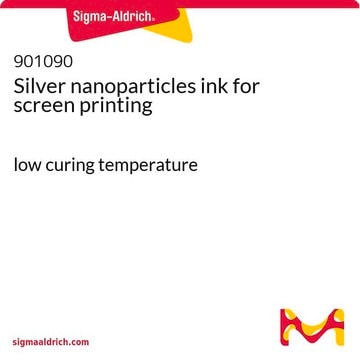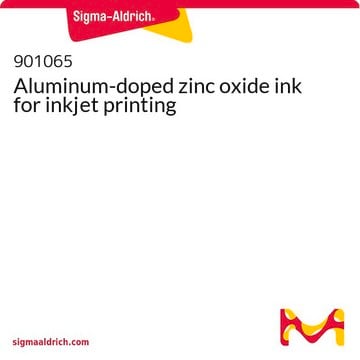792462
Carbon nanotube, single-walled
conductive organic solvent blend ink, 1 mg/mL SWCNT
Synonym(s):
SWCNT Ink, SWNT Ink, SWeNT V2V ink, SWeNT VC101 ink, Single-Walled Carbon Nanotube Ink, conductive ink
About This Item
Recommended Products
product name
Carbon nanotube, single-walled, solvent-based conductive ink, SWCNT, 1 mg/mL
form
viscous liquid (black)
Quality Level
greener alternative product characteristics
Design for Energy Efficiency
Learn more about the Principles of Green Chemistry.
sustainability
Greener Alternative Product
concentration
1 mg/mL
sheet resistance
<1000 Ω/sq, by 4-point probe on prepared (at 87.5% VLT (ohm/sq))
viscosity
17.7 Pa.s(25 °C) (at 10 sec-1 shear rate)
greener alternative category
, Enabling
storage temp.
2-8°C
Related Categories
General description
Application
Legal Information
Signis is a registered trademark of Chasm Advanced Materials, Inc.
CoMoCAT is a trademark of Chasm Advanced Materials, Inc.
CHASM is a trademark of Chasm Advanced Materials, Inc.
Signal Word
Danger
Hazard Statements
Precautionary Statements
Hazard Classifications
Acute Tox. 3 Oral - Acute Tox. 4 Inhalation - Aquatic Acute 1 - Eye Dam. 1 - Flam. Liq. 2 - Skin Corr. 1A - STOT SE 3
Target Organs
Central nervous system
Storage Class Code
3 - Flammable liquids
WGK
WGK 2
Certificates of Analysis (COA)
Search for Certificates of Analysis (COA) by entering the products Lot/Batch Number. Lot and Batch Numbers can be found on a product’s label following the words ‘Lot’ or ‘Batch’.
Already Own This Product?
Find documentation for the products that you have recently purchased in the Document Library.
Customers Also Viewed
Articles
Functional materials for printed electronics applications enable flexible displays, RFID tags, and biomedical sensors.
Recent advancements in paper-based sensing platforms offer cost-effective clinical diagnostics with microfluidic channels and colorimetric or electrochemical detection zones.
Carbon-based Sustainable Organic Electronics (SOE) limit the use of critical elements and biodegrade at their end-of-life. This review offers insight on how structural and energy disorder in these materials influence device performance and includes evaluations of various transport models and their limitations.
Boron nitride nanotubes (BNNT) are close structural analogs of carbon nanotubes (CNT), which are high aspect ratio nanotubular material, where carbon atoms are alternately substituted by nitrogen and boron atoms.
Our team of scientists has experience in all areas of research including Life Science, Material Science, Chemical Synthesis, Chromatography, Analytical and many others.
Contact Technical Service












